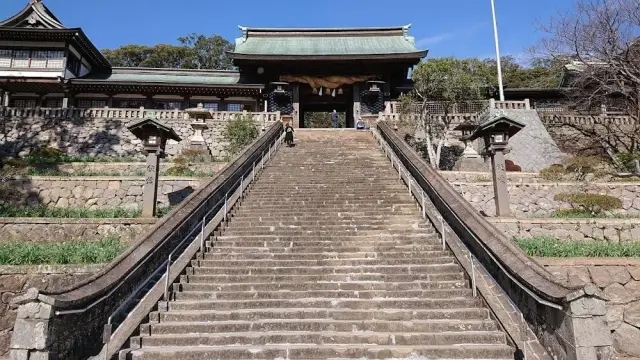https://www.dekitabi.com/itinerary/nagasaki-city-centre-walking-tour
Nagasaki, a city steeped in rich history and cultural diversity, offers travelers a unique glimpse into Japan’s storied past. From sacred shrines to historical landmarks, Nagasaki is a destination that invites exploration and discovery. Here’s a comprehensive guide to some of the city’s most fascinating sites, perfect for your next travel adventure.
Suwa Shrine

https://www.dekitabi.com/attraction/suwa-shrine-nagasaki
Perched on a hillside, Suwa Shrine is a beacon of spirituality and culture in Nagasaki. Established in the early 17th century, this Shinto shrine is renowned for its vibrant festivals, particularly the Nagasaki Kunchi Festival held every October. Visitors can marvel at the intricate carvings and detailed architecture of the shrine buildings while enjoying panoramic views of Nagasaki from the shrine grounds. A walk through the tranquil forested pathways leading to the shrine offers a serene escape from the bustling city below.
Ryoma’s Boots Statue

https://www.dekitabi.com/attraction/statue-of-ryoma’s-boots-nagasaki
Located near the Nagasaki Prefectural Office, the Ryoma’s Boots Statue commemorates Sakamoto Ryoma, a key figure in the Meiji Restoration. This quirky statue, depicting Ryoma’s oversized boots, symbolizes his forward-thinking vision and the steps he took towards modernizing Japan. It’s a popular photo spot and a nod to Ryoma’s enduring legacy. Nearby, visitors can explore various historical markers and learn more about Ryoma’s contributions to Japan’s transformation.
Nagasaki City Kameyama Shachu Memorial Hall

https://www.dekitabi.com/attraction/kameyama-shachu-memorial-museum
The Kameyama Shachu Memorial Hall is dedicated to Sakamoto Ryoma and his naval trading company, Kameyama Shachu, which played a crucial role in Japan’s modernization. The hall houses a collection of artifacts, documents, and exhibits detailing Ryoma’s life and the activities of his company. The memorial hall is set in a picturesque location, offering stunning views of Nagasaki’s harbor and providing a deeper understanding of the city’s historical significance.
Kofukuji Temple

https://www.dekitabi.com/attraction/kofukuji-temple-nagasaki
Kofukuji Temple, established in 1620, is the oldest Obaku Zen temple in Nagasaki. Known for its Chinese architectural style, Kofukuji was built by Chinese immigrants and served as a place of worship and community. The temple’s serene atmosphere, coupled with its beautifully maintained gardens and historical buildings, offers a peaceful retreat. Visitors can explore the temple grounds, including the iconic Daiohoden Hall and the tranquil pond, while reflecting on the cultural exchanges between Japan and China.
Megane Bridge

https://www.dekitabi.com/attraction/megane-bridge-nagasaki
Megane Bridge, or Spectacles Bridge, is one of Nagasaki’s most iconic landmarks. Built in 1634, this stone arch bridge earned its name due to its reflection in the river resembling a pair of spectacles. Megane Bridge is not only a marvel of engineering but also a testament to the city’s resilience, having withstood numerous floods over the centuries. A stroll along the Nakashima River, where the bridge is located, provides picturesque views and a sense of the historical ambiance of Nagasaki.
Sofukuji Temple

https://www.dekitabi.com/attraction/sofuku-ji-nagasaki
Another example of Chinese influence in Nagasaki, Sofukuji Temple was founded in 1629 by Chinese immigrants. This Obaku Zen temple features distinctive Ming Dynasty-style architecture, including the impressive Daiippomon Gate and the Great Buddha Hall. Sofukuji Temple is an important cultural site, showcasing the blend of Chinese and Japanese traditions. Visitors can enjoy the tranquil gardens, historical buildings, and various cultural events held throughout the year.
Nagasaki Shinchi Chinatown

https://www.dekitabi.com/attraction/shinchi-chinatown-nagasaki
Nagasaki Shinchi Chinatown is the oldest Chinatown in Japan, dating back to the 17th century. This vibrant district is a hub of culinary delights, cultural festivities, and unique shopping experiences. Visitors can savor authentic Chinese cuisine, explore traditional shops, and participate in the annual Nagasaki Lantern Festival, which illuminates the streets with thousands of colorful lanterns. Nagasaki Shinchi Chinatown is a lively area that reflects the city’s multicultural heritage.
Dutch Slope

https://www.dekitabi.com/attraction/dutch-slope-nagasaki
The Dutch Slope, or “Hollander Slope,” is a charming hillside area that was once home to Nagasaki’s foreign residents during the late 19th and early 20th centuries. The cobblestone streets and Western-style houses provide a glimpse into the past when Nagasaki was one of Japan’s few open ports for foreign trade. Walking through this historic district, visitors can admire the well-preserved architecture and enjoy the panoramic views of the city and harbor.
Oura Cathedral

https://www.dekitabi.com/attraction/oura-cathedral-nagasaki
Oura Cathedral, also known as the Basilica of the Twenty-Six Holy Martyrs of Japan, is the oldest surviving Christian church in Japan. Built in 1864 by French missionaries, this Gothic-style cathedral commemorates the 26 martyrs who were executed in Nagasaki in 1597. Oura Cathedral is a designated National Treasure and remains an active place of worship. Visitors can explore the beautiful stained glass windows, historical artifacts, and the serene garden surrounding the cathedral.
Former Hong Kong and Shanghai Bank Nagasaki Branch

https://www.dekitabi.com/attraction/shanghai-bank-nagasaki-branch-museum
The Former Hong Kong and Shanghai Bank Nagasaki Branch is a stunning example of early 20th-century Western architecture. Constructed in 1904, this building served as a branch of the prominent bank during Nagasaki’s period of international trade expansion. Today, it houses the Nagasaki City Museum of History and Folklore, where visitors can learn about the city’s rich maritime history and its role in global commerce. The building itself, with its elegant design and historical significance, is a highlight of any visit to Nagasaki.
Conclusion
Nagasaki’s diverse array of historical and cultural sites provides a rich tapestry of experiences for travelers. Whether exploring sacred shrines, historical memorials, or vibrant districts, visitors are sure to find a unique blend of Japanese and international influences that define Nagasaki’s charm. As you plan your journey through this captivating city, immerse yourself in its history, culture, and breathtaking landscapes for an unforgettable travel experience.


Leave a Reply